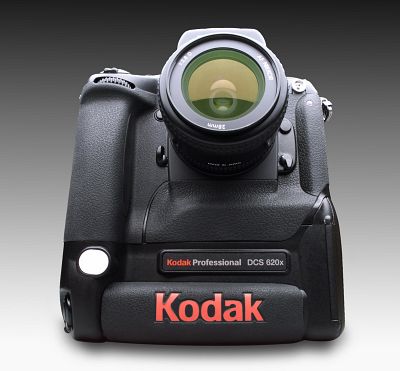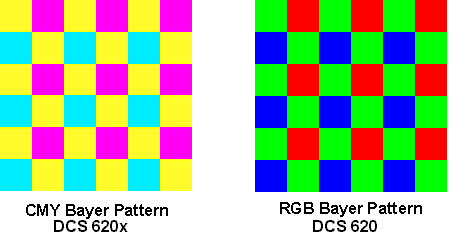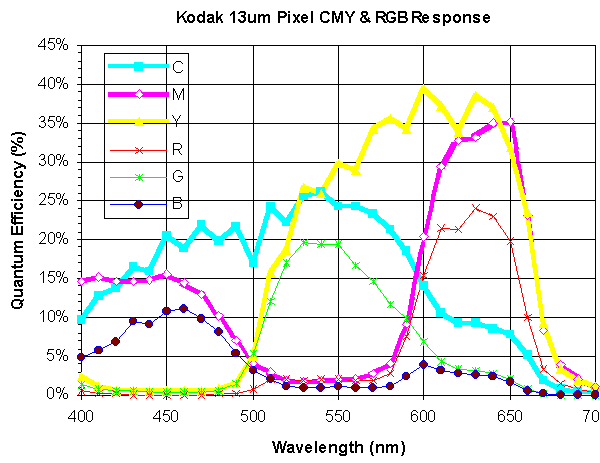|
|
|
Kodak
Professional's new DCS 620x
digital camera, pushing the
boundaries of available-light
shooting. This
new version of the DCS 620
digital camera performs at up
to ISO 6400 and delivers
improved image quality with
its innovative high
performance 2-megapixel CCD,
utilizing a
Cyan-Magenta-Yellow (CMY)
Bayer pattern color filter
array. ISO
400 Sample Daylight,
Nikkor f2.8 80-200mm f2.8 zoom lens,
Auto White Balance, Aperture Priority,
Matrix Metering, Aperture f8, Shutter
1/2500th, Anti-Aliasing filter
installed, Acquire Module Version
5.9.0.9. Click
on the preview at left for a 1200 x 800
pixel, 297 KB full screen
view. ISO
1600 Sample Available
Light, Nikkor f2.8 400mm lens, Aperture
f2.8, Shutter 1/1000th, Anti-Aliasing
filter installed, Acquire Module
Version 5.9.0.9. Click
on the preview at left for a 1200 x 984
pixel, 296 KB full screen view
*. *Photo
courtesy of Dallas area pro
photographer (and good friend)
Moses
Olmos.
ISO
3200 Sample Available
Light, Nikkor f2.8 28mm lens, Auto
White Balance, Programmed Automatic
Exposure, Matrix Metering, Aperture
f2.8, Shutter 1/200th, Anti-Aliasing
filter installed, Acquire Module
Version 5.9.0.9. Click
on the preview at left for a 1200 x 800
pixel, 384 KB full screen
view. ISO
6400 Sample Available
Light, Nikkor f2.8 28mm lens, Auto
White Balance, Programmed Automatic
Exposure, Matrix Metering, Aperture
f5.6, Shutter 1/125th, Anti-Aliasing
filter installed, Acquire Module
Version 5.9.0.9. Click
on the preview at left for a 1200 x 800
pixel, 408 KB full screen
view.
The
Technology Inside the 620x By Stephen A.
Noble, Advanced Development Manager The new Kodak
Professional DCS 620x digital camera, a variant
of the DCS 620 (which remains available), is
notable for its ISO range of from 400 to 6400
(calibrated from ISO 400-4000), and its
impressive image quality. Key to these features
are a new 2-megapixel indium tin oxide CCD
(charge couple device), new color filter array
(CFA) pattern, and new low-noise electronics.
The camera is ideal for fast-action, low-light
and changing lighting conditions. Kodak's
high-performance 2-megapixel CCD in the DCS 620x
utilizes a Cyan-Magenta-Yellow (CMY) Bayer
pattern color filter array. This new color
pattern (shown below) looks very similar to the
RGB Bayer pattern used in the DCS
620. In fact, Dr.
Bayer, a Kodak scientist who invented the Bayer
pattern approximately 20 years ago, suggested in
his original patent that either RGB or CMY
colors could be employed. Until now, Kodak DCS
cameras have employed the RGB pattern because of
issues with color fidelity and CCD
manufacturing. However, CMY deployment is now
possible, thanks to groundbreaking advancements
in CCD design with indium tin oxide (ITO)
materials and newly developed CFA manufacturing
techniques. The major
advantage of CMY CFA colors is sensitivity, or
speed. In photographic terms, speed is
equivalent to ISO. The CMY CFA has two
attributes that increase effective
speed: · Less
unwanted dye absorption · Increased
color signal and signal-to-noise
ratio The reduced dye
absorption behavior of a CMY CFA is easy to
explain. In the RGB CFA system, each color is
"built" from a combination of two of three
available dye layers - cyan (C), magenta (M) or
yellow (Y). For example, the green layer is
"built" by combining one layer of yellow and one
layer of cyan. Therefore, the
RGBs are built with the following
formulas: Red = Y +
M Green = Y +
C Blue = M + C
Even though a
single color - say, Y - is supposed to pass
yellow color and absorb all others; it has a
tendency to absorb yellow as well. This is
called unwanted absorption. Since both colors
that make up any particular primary RGB color
have unwanted absorption, this further reduces
the amount of light that passes through to the
CCD. In the CMY system, there is only one dye
color for each primary color. So this system has
less unwanted absorption, effectively passing
more primary light to the CCD. The discussion
around increased signal is a bit more
complicated. First, let's examine a few basics
on how CCD's work.1 The photoactive area of a
CCD pixel is the region that converts light to
electrical charge. This electrical charge is
proportional to the amount of light striking the
pixel. To create a CCD readout, the electrical
charge is converted into a proportional voltage,
and the A/D (analog to digital) converter
subsequently samples this voltage. When the camera
shutter "takes" the picture, each CCD pixel is
presented with an amount of light that
originated in the scene being photographed.
Also, each color in the scene is made up of
different amounts of energy at particular
wavelengths of light. All the wavelengths of
light striking the pixel are "integrated"
(averaged together) to form the signal at each
pixel. If a pixel has a
color dye placed above it, as in the case of a
color CCD, then that pixel will respond more to
that particular color. Therefore, the green
pixels in a RGB Bayer pattern CCD respond more
to green scene content, but the total green
signal is developed by integrating all the
energies in the entire 400-700nm wavelength
band. In the case of
green, that means more energy is allowed to pass
through to the CCD in the green area of the
spectrum and less in others. Refer to the CCD
response vs. wavelength chart below. This chart shows
both an RGB and a CMY CCD response. The chart
was made by combining data from the two
different CCD systems. Note the green line,
which is the green response of the RGB system.
Compare it to the yellow line, which is the
yellow response of the CMY system. You should
notice two attributes. First, the
yellow curve is much larger in overall amplitude
(approximately 37% yellow vs. 20% green). This
occurs because of the reduction in unwanted
absorption mentioned earlier. Second, you should
notice that the area "under the curve" for the
yellow is much larger than the green signal.
Notice that yellow starts rising at about 500nm
and stops responding at 700nm, but the green
signal, while it also starts at 500nm, ends at
around 600nm. If you were to
shine a light source that has constant energy at
all wavelengths onto the CCD, the yellow signal
would be about twice as large as the green
signal. This occurs because the yellow signal
integrates more light compared to the green
signal. Since in either case the noise in the
underlying CCD is constant, we also have larger
signal-to-noise ratio (SNR) in the CMY system.
This larger signal provides higher effective
ISO, and the increased SNR provides for more ISO
range. The increased
ISO range was used to maximum advantage in the
DCS 620x system. Note that the DCS 620 has an
ISO range of 8x - 200 to 1600 - while the DCS
620x has a range of 16x - 400 to 6400. The
larger signal of the CMY system provides the
increased base ISO of 400, and the greater SNR
provides for the increased ISO range. As mentioned
earlier, the DCS 620x also incorporates new
lower-noise analog electronics compared to the
DCS 620. This further increases SNR, and
enhances the ISO range of the CMY system. While
this is very difficult to see at the base ISO of
400, the image quality improvement at ISO 6400
is quite noticeable. It is precisely
that image quality at very high ISO settings
that will appeal to photographers who shoot
digital images in changing and dim-lighting
conditions. For them, the most important thing
is to "get the shot," but not at the cost of
poor image quality. With its unique combination
of technology, the DCS 620x provides the perfect
solution.
Camera
Information (From Kodak) "Photojournalists
and other professionals have already come to
rely heavily on our DCS 620 camera," said Peter
Jameson, Director, Digital Capture, Kodak
Professional. "This enhanced version of the
camera will make it even more invaluable for
photographers who are challenged to shoot fast
action or in low-light conditions, including
sports/action, medical and scientific imaging,
government, military and law enforcement. The
DCS 620x camera offers improved flexibility and
expandability along with increased quality - a
truly winning equation." Key to the DCS
620x digital camera are a new CCD (charge couple
device), color filter array (CFA) pattern, and
low-noise electronics. The new CFA on Kodak's
2-megapixel ITO (indium tin oxide) CCD provides
enhanced spectral response, producing high
picture quality at extremely high ISO
ranges. Like the DCS 620
camera, the DCS 620x is built on the Nikon F5
platform and retains all the durability,
functionality and lens compatibility of that
single-lens-reflex camera. The Kodak
Professional DCS 620x camera provides a host of
features that ensure superior image quality and
higher color saturation. In addition to a new
software noise reduction filter, the DCS 620x
offers Kodak's "Picture Protection" - a range of
features that includes post-shot exposure
compensation, white balance corrections and file
recovery. Plus,
photographers can customize the DCS 620x with
such options as removable anti-aliasing and IR
blocking filters, IPTC captioning, white balance
uploading, direct cellular phone transmission,
and a wide choice of storage options. Innovative
Features: The new camera
follows closely on the introduction of the
latest DCS series firmware and software upgrades
that include enabling dual memory card slots,
GPS data recording and laptop-free image
transmission via cellular phones. Q&A's How
does the DCS 620x differ from the DCS 620
digital camera? The DCS 620x has
all the functionality of the DCS 620, but also
incorporates a new CCD (charge couple device),
color filter array (CFA) pattern, and low-noise
electronics. As a result, the DCS 620x features
ISO settings ranging from 400 to 6400. The new
CFA on Kodak's 2-megapixel indium tin oxide CCD
delivers enhanced spectral response for
high-quality images at extremely high ISO ranges
and with greater color saturation. Who
will benefit most from the DCS
620x? Photojournalists,
especially those shooting sports and action;
photographers in the medical, scientific
imaging, government, military and law
enforcement fields; and others who have to
capture digital images in low-light or changing
lighting conditions. What
other features does the DCS 620x
offer? The DCS 620x has
a range of features that ensure superior image
quality and higher color saturation. In addition
to a new software noise reduction filter, the
DCS 620x offers "Picture Protection" - a menu of
features that includes post-shot exposure
compensation, white balance corrections and file
recovery. Photographers can customize the camera
with such options as removable anti-aliasing and
IR blocking filters, IPTC captioning, white
balance uploading, direct cellular phone
transmission, and a wide choice of storage
options. Does
the new camera replace the DCS
620? No, there is a
market for both. The DCS 620, as well as the DCS
520, remain in Kodak's award-winning line of
professional digital cameras. Given
the advances in the DCS 620x, why would anyone
want to buy a DCS 620?
The DCS 620 is
an excellent camera in its own right, offering
high performance with an ISO range of 200-1600.
For photographers who don't need extended
low-light capabilities, the DCS 620 provides all
the features of the DCS 620x at a reduced
price. You say
the DCS 620x has an ISO of up to 6400, but is
calibrated only to ISO 4000. What does that mean
exactly? The DCS 620x
camera is optimized, calibrated and tested for
operation from ISO 400 to ISO 4000. Comments
from early users suggested that, for low-light
photography at very high ISO, the trade-off of
quality for speed is acceptable. So the camera
can be operated at up to ISO 6400, but image
quality and color may not be suitable for some
applications. Why is
the lowest ISO setting 400 when other cameras
offer lower settings? The DCS 620x is
designed specifically for photographers who
shoot - especially action - in low light, and a
400 ISO is the minimum setting for that
situation. |


.jpg)
.jpg)
.jpg)
.jpg)

